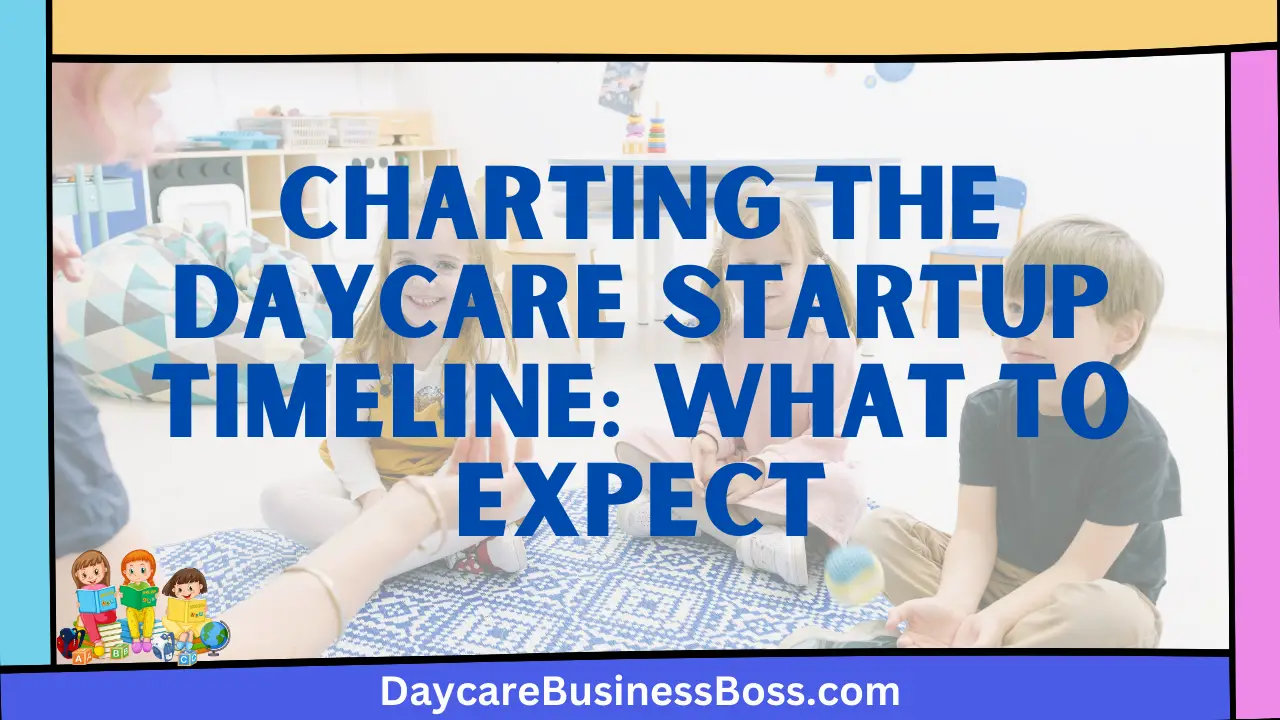Starting a daycare is more than just a step toward entrepreneurship; it is a commitment to influencing young lives and establishing a supportive environment for children’s growth. As you embark on the journey of establishing a daycare, one critical issue looms large: How long will it take to make your dream into a reality? The path from concept to bustling daycare center involves several stages, each requiring careful analysis and planning.
To efficiently start with a daycare, you should prioritize meticulous planning, licensing, staffing, and adherence to regulations. Be aware that the timeline, lasting several months to a year, hinges on factors like location and preparedness.
In this article, we delve into the complexities of the childcare startup timetable, investigating the elements that impact its length and providing insights to assist you in managing this exciting yet time-sensitive enterprise.
Meticulous Planning: The Foundation of Growth

A painstakingly constructed plan is the core of any thriving venture, and the establishment of a daycare is no exception. This crucial stage of meticulous planning serves as the foundation for your daycare’s eventual growth. The start of this trip requires the precise delineation of goals and objectives that will map the way for your daycare’s journey. To begin this path, you must first decide which age groups your daycare will serve. Will you concentrate on babies, toddlers, or preschoolers? This choice will act as the nucleus around which your entire business will revolve.
The unique selling characteristics of your childcare deserve careful consideration in this comprehensive blueprint. What distinguishes your establishment from the plethora of alternatives? These distinguishing elements, whether it’s a specific curriculum, great facilities, or a unique approach to early childhood education, are the foundations of your daycare’s identity.
A properly defined teaching philosophy and curriculum should be incorporated into your planning process. This key feature defines the strategies for imparting knowledge and skills to the young minds entrusted to your care. Will you prioritize play-based learning, a structured academic program, or a combination of the two? This attitude not only affects the educational experience but also serves as a guideline for staff recruitment and training.
Your planning extends beyond the conceptual world into the tangible regions of your daycare’s physical layout. The spatial requirements must be carefully tuned to accommodate the quantity of youngsters. This careful consideration ensures an appropriate combination of open space for exploration and the construction of comfortable nooks for relaxation and leisure.
Your daycare’s architectural design is critical in providing an atmosphere that effortlessly integrates safety, stimulation, and learning. The layout of play areas, complete with age-appropriate toys and activities, is critical in encouraging creativity and curiosity. Simultaneously, the sleeping rooms should be designed to promote good sleep patterns by evoking a sense of security and tranquility.
Providing dining facilities involves careful planning to guarantee that the children’s nutritional needs are satisfied effectively. The selection of furnishings, fittings, and materials must adhere to ergonomic and safety regulations.
Read more about: Beginners’ Guide to Daycare Entrepreneurship: What You Must Know
Navigating the Licensing Maze
Obtaining the necessary licenses is a critical and necessary step in the complicated process of starting a daycare. This critical step, which is frequently nuanced and multifaceted, demands alert attention and proactive engagement. The world of daycare licensing is a diverse environment, its contours defined by your endeavor’s geographical coordinates. In this perilous region, diligent study serves as a compass, guiding your efforts toward effective regulatory navigation.
The crucial issue of safety is central to this maze of regulations. Licensing standards cover a wide range of issues, all of which highlight the critical need to protect the safety and well-being of the children in your care. Safety standards serve as the foundation, controlling everything from physical space layout to emergency protocol requirements.
Another critical aspect of the licensing framework is staff-to-child ratios. These ratios are intended to ensure that each kid receives the specialized attention and care required for his or her development and safety. Following these ratios guarantees that your daycare creates a loving atmosphere in which children can thrive.
Another critical component is health inspections, which highlight the importance of maintaining a clean and healthy environment. These inspections cover everything from the cleanliness of the facilities to the correct handling and storage of food. Each rigorous inspection guarantees that children are immersed in an environment that promotes their health and well-being.
However, the licensing process comprises more than just a list of qualifications. It’s a complicated network of paperwork, inspections, and occasionally required training sessions. Starting on this path early is wise advice, as gaining licenses may be a lengthy and time-consuming procedure. Setting the wheels in motion far in advance reduces the chance of unwelcome delays that could impede your daycare’s early opening.
Failure to obtain the necessary permissions or to follow the rules and regulations might have serious implications. Your daycare may be forced to close, causing irreversible disruptions that affect not just your business but also the families and children who rely on your services. Thus, paying close attention to the licensing requirements is more than just a formality; it’s the pivot around which the smooth running of your daycare revolves.
Building a Dedicated Staff
The function of a daycare’s personnel is a linchpin in the delicate tapestry of its growth, influencing every aspect of the children’s experience. This human structure serves as a channel for care, education, and inspiration. The aggregate knowledge and unshakable passion of your team is the hallmark of an exceptional daycare experience since they are the ones who bring the daycare’s vision to life.
In the goal of fostering growth, learning, and safety, assembling a staff of exceptional caliber takes center stage. The reverberation of their impact reaches far beyond the bounds of the daycare’s physical area, influencing the children’s lives profoundly. This aspect underlines the need not just to obtain qualifications but also to connect the values of the team with the daycare’s goal.
The recruitment process begins with an exploration phase. In-depth interviews allow you to learn about the personalities and instructional methods that potential staff members bring to the table. This window of engagement allows for an assessment of how these individuals might fit into the daycare’s ethos. Concurrently, background checks and reference checks serve as sentinels, protecting against potential threats and ensuring that persons entrusted with the care of children are trustworthy and capable.
Your staff size is inextricably tied to the size of your daycare and the age groups you wish to serve. This factor has a substantial impact on the quality of supervision and the safety of the youngsters. Adequate staffing ensures that each child receives customized attention and care, fostering an atmosphere in which they can thrive and explore without jeopardizing their safety.
Teachers and caregivers occupy center stage in the symphony of roles because they interact with the children regularly, encouraging their growth and kindling their curiosity. The composition, however, goes beyond these key players. Administrative staff employees play an important role in the daycare’s operations. Their expertise in scheduling, record-keeping, and parent communication harmonizes the daycare’s complex parts into a coherent and smooth-flowing experience.
As you bring together this group of people, each one plays a different note, but together they produce a harmonious melody that characterizes the spirit of your daycare. Their virtuosity in their roles resonates powerfully with the families who entrust their children’s well-being to your care. The daycare develops into a haven of growth, wonder, and security thanks to the passion and expertise of this team.
Compliance with Regulations: Non-Negotiable

Regulatory compliance emerges as a cornerstone in the convoluted landscape of starting a daycare, solidifying the basis upon which the safety, well-being, and prosperity of the children and your establishment lie. This non-negotiable aspect is a dynamic commitment that creates the very essence of your daycare’s identity.
The triad of health, safety, and sanitation standards is central to this compliance path. These pillars work together to create a safe and nurturing environment for the children in your care. Following rigorously established rules ensures that the food made and presented to children is not only healthy but also prepared in a way that protects their health. Developing complete emergency protocols prepares your personnel to respond efficiently and quickly in times of crisis, ensuring the children’s safety is not jeopardized. Strict commitment to sanitation practices results in a space that is clean, sanitary, and conducive to healthy development.
Regular inspections to guarantee continuing compliance are an example of a proactive commitment to sustaining these standards. These evaluations are more than just regulatory checkpoints; they are a strong tool to ensure that your daycare continually embraces the values of safety and well-being. This dynamic interaction with compliance demonstrates your passion and accountability.
Maintaining optimum staff-to-child ratios is a staged act in the complicated dance of childcare that supports the full development of each kid. These ratios are meticulously calibrated to ensure that each kid receives the specialized attention and care necessary for their development. Deviation from these ratios is more than just a blunder; it can have catastrophic ramifications. Fines and penalties may be imposed, and in extreme circumstances, your daycare’s operation may be compromised. This element emphasizes the need for compliance in protecting not just children, but also the viability of your organization.
Compliance with these standards goes beyond mere compliance; it resonates in the resonance of your daycare’s reputation and credibility. The meticulous dedication you provide resonates with families looking for a safe and supportive environment for their children. This commitment to compliance conveys that your daycare is more than just a haven for children.
Read more about: Charting the Daycare Startup Timeline: What to Expect
Understanding the Timeline: Factors at Play
Starting a daycare requires an understanding that the timing for this enterprise is far from consistent. A symphony of variables influences the cadence of your attempt, with each note playing an important role in orchestrating the launch of your daycare. Realism is the compass that guides your expectations as you navigate this complicated composition.
The geographical location of your daycare is an important conductor of this symphony. Regional differences in legislation and regulatory processes have the potential to accelerate or stall your startup schedule. The regulatory landscape is a mosaic that varies by location. It is therefore critical to arm oneself with knowledge by researching the relevant rules and criteria in your area. This not only functions as a navigation tool, but it also allows you to allocate time wisely while taking into consideration the complexities of your surroundings.
Aside from geographical constraints, the complexities of licensing laws add their notes to the music. While licensing is an important step, it may be complicated and multifaceted. The amount of time it takes to complete this process can be impacted by how meticulously you prepare. A thorough study of the regulations, together with proactive involvement with the licensing authorities, can greatly shorten the schedule for this component of the process. The better prepared you are, the easier this phase will be. Adequate planning, similar to practicing a performance, guarantees that each note is played smoothly, minimizing the possibility of delays.
Within the context of preparedness, communication is a critical tool. Establishing communication with appropriate authorities and specialists indicates your commitment and can pave the way for the resolution of potential stumbling blocks. This proactive approach, similar to tuning an instrument, guarantees that the startup process runs well.
The pacing of your timeline is dictated not just by characteristics you can predict, but also by unexpected notes that may occur. Unexpected hurdles are an inevitable element of every venture, and the establishment of a daycare is no exception. These could include everything from supply chain disruptions to unforeseen regulatory changes. Navigating these unfamiliar terrains necessitates flexibility and adaptability, for it is in these moments that your determination shines clearest.
Frequently Asked Questions

How long does it take to open a daycare center?
The time it takes to open a daycare depends on several factors, including location, legal regulations, and your level of preparedness. In most cases, the process takes several months to a year. The schedule is influenced by extensive planning, getting licenses, setting up the physical location, assembling personnel, and assuring regulatory compliance.
What are the most important regulations to consider while opening a daycare?
To protect the safety and well-being of the children in your care, you must follow several requirements while opening a daycare. Health and safety standards, staff-to-child ratios, food preparation and cleanliness, emergency plans, and licensing requirements are frequently covered in these rules. Compliance with these regulations is critical for maintaining confidence and creating a secure environment.
How do I create an efficient daycare staff?
A careful hiring process is required to build an effective daycare team. Look for people who not only meet your qualifications but also share your vision for childcare. To confirm their dependability, conduct rigorous interviews, background checks, and reference checks. The amount of your employees will be determined by the capacity of your daycare and the age groups you serve. Adequate personnel is critical for maintaining proper monitoring and assuring the safety and development of the children.
To learn more on how to start your own daycare checkout my startup documents here.
The information provided by DaycareBusinessBoss.com (“The Site”) is for general informational purposes only. All information on the Site is provided in good faith, however, we make no representation or warranty of any kind, express or implied, regarding the accuracy, adequacy, validity, reliability, availability or completeness of any information on the Site. Under no circumstance shall we have any liability to you for any loss or damage of any kind incurred as a result of the use of the Site or Reliance on any information provided on the Site. Your use of the Site and your reliance on any information on the Site is solely at your own risk.
This blog post is for educational purposes only and does not constitute legal advice. Please consult a legal expert to address your specific needs. Terms and Conditions. (https://daycarebusinessboss.com/terms-conditions/)

Meet Shawn Chun: Entrepreneur and Childcare Business Fan.
I’m a happy individual who happens to be an entrepreneur. I have owned several types of businesses in my life from a coffee shop to an import and export business to an online review business plus a few more and now I create online daycare business resources for those interested in starting new ventures. It’s demanding work but I love it. I do it for those passionate about their business and their goals. That’s why when I meet a childcare business owner, I see myself. I know how hard the struggle is to retain clients, find good employees and keep the business growing all while trying to stay competitive.
That’s why I created Daycare Business Boss: I want to help childcare business owners like you build a thriving business that brings you endless joy and supports your ideal lifestyle.


